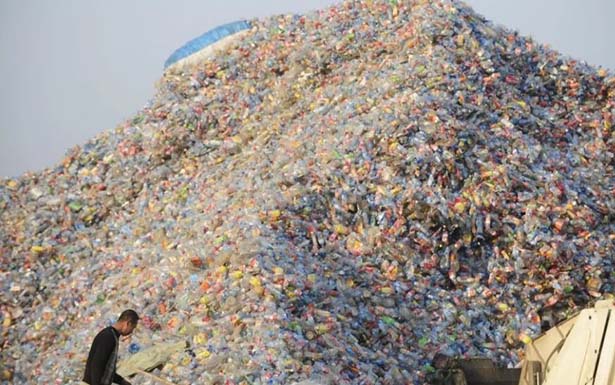- Research in the United States suggests that the ban will leave 111 million tons of plastic garbage displaced by 2030, while waste that used to be exported accumulates in Japan.
- Waste exports from the west to Malaysia, Vietnam and India on the rise, but illegal dumping prompts calls to follow China and impose restrictions
China’s ban on plastic waste imports is forcing nations like Japan and the United States to seek new ways to deal with their garbage, including exporting recyclable waste to Southeast Asia.
But instead of finding solutions, it seems that the problem of disposing of recyclables has only been exacerbated, especially with the exploitation of developing countries like Malaysia and Vietnam, which lack the regulatory infrastructure to prevent illegal dumping.
The side effects of developed nations that are banned from shipping their scrap metal waste to China, formerly the world’s largest importer of plastic waste for recycling, have also emerged in Japan.
Waste management companies are being inundated with requests to handle the additional plastic waste, but many have reached their legal limits.
US cities fight to rewrite rules on recycling after China restricts foreign trash
“Warehouses of intermediary companies are full of garbage from companies and factories,” said an official from a waste management company in Kanagawa prefecture.
China was criticized at a meeting of the World Trade Organization in October for its abrupt policy change, which many Western countries believe is harmful to the global environment.
But after decades of importing most of the world’s garbage, China has had enough, something that advocates and activists say should come as no surprise, as China, the world’s second-largest economy, has an obligation to consider the health of your own people.
Based on quality of life, the nation has naturally decided to reduce its emissions, including those from recycling plastics, experts say.
For decades, nearly half of the planet’s garbage had been sent to China, where items such as single-use soda bottles, food wrappers and plastic bags were recycled to produce more plastics and raw materials for chemicals.
In 2015, China imported about 47 million metric tons of recyclable waste, according to US media reports. According to Science Advances magazine, research conducted at the University of Georgia shows that China’s import ban will leave 111 million metric tons of plastic garbage displaced by 2030.
In July last year, China said it would ban 24 types of solid waste, including plastics, waste paper and discarded textiles, from overseas vendors due to the damage it causes to the environment and people’s health.
Since the ban in January this year, recycling companies around the world have been thrown into chaos, with recyclable waste piling up at waste treatment sites, according to Western media.
Now China refuses to dump the earth for the world’s waste, where the hell will it all go?
In Japan, even if middle processors are tasked with disposing of recyclable waste, facilities are subject to legal limits and there are many suppliers who refuse to accept the waste.
Japan exports around 1.5 million tonnes of plastic waste per year and as of last year, about half went to China. According to a quarter of 102 local governments that responded to a survey by the Environment Ministry, the amount of plastics stored in local scrap metal companies increased between January and July, with some reporting that accumulated waste had exceeded legal limits.
Boundary violations were found in five local governments, while 34 municipalities said they were struggling to find destinations for their waste.
Plastic waste disposal increased by 56% of intermediate processors that incinerate or shred plastics and 25% of final processors that bury waste in landfills, while 34.9% of companies said they limited or considered restrict the amount of plastics they accept.
China’s waste ban has rocked the recycling world and revealed Hong Kong’s dismal record. What’s next for the city’s growing mountains of trash?
Japan produces the highest amount of plastic waste per person after the United States and has lagged behind other countries in controlling the use of plastics despite growing fear of environmental pollution.
Some industry experts say the only option is to improve the technical capabilities of recycling facilities through deregulation, as well as increase awareness of wasteful behavior among retailers and consumers.
The ministry is compiling a strategy to reduce plastic waste, and sources say it is considering including a numerical target to reduce the amount of disposable plastic waste by 25 percent by 2030, while increasing the use of eco-friendly bioplastics made from plants.
Countries like the US, which saw most of the situation as the world’s largest exporter of scrap metal, raised the import ban at the WTO meeting on October 22. Along with the European Union, South Korea, Canada and Australia, Washington expressed concern that China is not giving a sufficient explanation for its policy change.
Dead whale washed up in Indonesia with 115 plastic cups, 25 carry bags and a pair of flip flops on its stomach.
The United States argued that if the disruption to the global recycling trade continued, “there could be a greater threat of increased marine litter,” among other complaints. Japan also expressed concern about the recycling crisis.
However, China has become even more committed, saying it plans to expand its ban on importing waste materials to cover more categories. It says waste facilities that do not meet environmental standards remain rampant, leading to water and air pollution.
“The problem of foreign garbage is detested by everyone in China,” an official in charge of international cooperation at China’s ministry of environmental protection told a news conference when the ban was announced in July last year.
Since China’s ban, exports from the United States and other Western nations to countries such as Malaysia, Vietnam and India have increased. But after it was revealed in October that a lot of illegal dumping had taken place in Malaysia, many developing nations have hinted that they intend to follow in China’s footsteps with their own restrictions on recyclable waste.
In any case, the policy is forcing wealthy nations to rethink what to do with their waste in the long run now that they can no longer dispose of it in China’s backyard.




